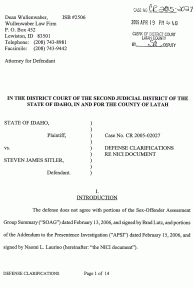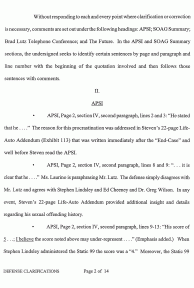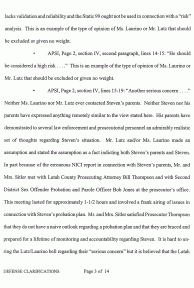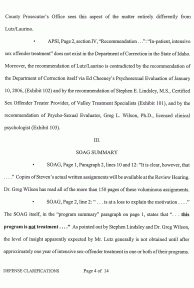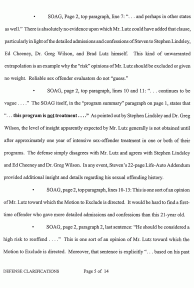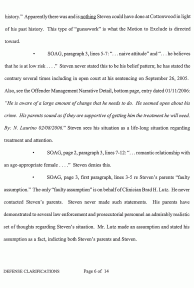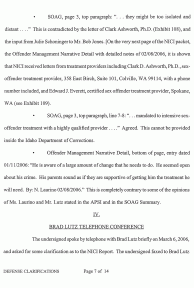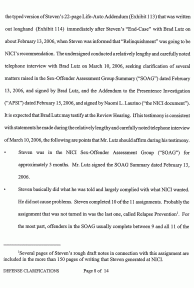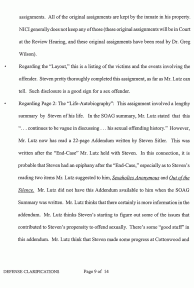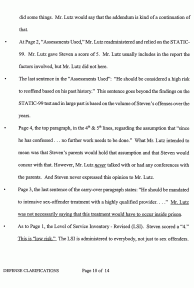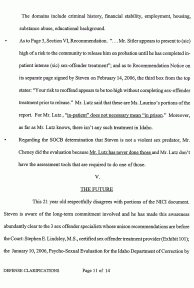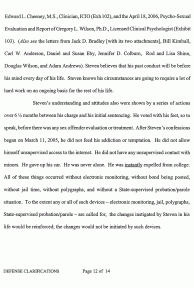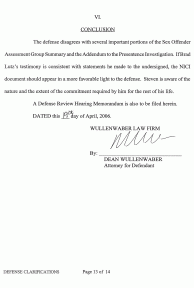Dean Wullenwaber, ISB #2506
Wullenwaber Law Firm
P. O. Box 452
Lewiston, ID 83501
Telephone: (208) 743-8981
Facsimile: (208) 743-9442Attorney for Defendant
IN THE DISTRICT COURT OF THE SECOND JUDICIAL DISTRICT OF THE
STATE OF IDAHO, IN AND FOR THE COUNTY OF LATAHSTATE OF IDAHO,
Plaintiff,vs.
STEVEN JAMES SITLER,
Defendant.Case No. CR 2005-02027
DEFENSE CLARIFICATIONS
RE NICI DOCUMENTI.
INTRODUCTIONThe defense does not agree with portions of the Sex-Offender Assessment Group Summary (“SOAG”) dated February 13, 2006, and signed by Brad Lutz, and portions of the Addendum to the Presentence Investigation (“APSI”) dated February 15, 2006, and signed by Naomi L. Laurino (hereinafter: “the NICI document”).
Without responding to each and every point where clarification or correction is necessary, comments are set out under the following headings: APSI; SOAG Summary; Brad Lutz Telephone Conference; and The Future. In the APSI and SOAG Summary sections, the undersigned seeks to identify certain sentences by page and paragraph and line number with the beginning of the quotation involved and then follows those sentences with comments.
II.
APSI
- APSI, Page 2, section IV, second paragraph, lines 2 and 3: “He stated that he. . . .” The reason for this procrastination was addressed in Steven’s 22-page Life-Auto Addendum (Exhibit 113) that was written immediately after the “End-Case” and well before Steven read the APSI.
- APSI, Page 2, section IV, second paragraph, lines 8 and 9: “. . . it is clear that he. . . .” Ms. Laurino is paraphrasing Mr. Lutz. The defense simply disagrees with Mr. Lutz and agrees with Stephen Lindsley and Ed Cheeney and Dr. Greg Wilson. In any event, Steven’s 22-page Life-Auto Addendum provided additional insight and details regarding his sexual offending history.
- APSI, Page 2, section IV, second paragraph, lines 9–13: “His score of 5. . .; I believe the score noted above may under-represent. . . .” (Emphasis added.) When Stephen Lindsley administered the Static 99 the score was a “4.” Moreover, the Static 99 lacks validation and reliability and the Static 99 ought not be used in connection with a “risk” analysis. This is an example of the type of opinion of Ms. Laurino or Mr. Lutz that should be excluded or given no weight.
- APSI, Page 2, section IV, second paragraph, lines 14–15: “He should be considered a high risk. . . .” This is an example of the type of opinion of Ms. Laurino or Mr. Lutz that should be excluded or given no weight.
- APSI, Page 2, section IV, lines 15–19: “Another serious concern. . . .” Neither Ms. Laurino nor Mr. Lutz ever contacted Steven’s parents. Neither Steven nor his parents have expressed anything remotely similar to the view stated here. His parents have demonstrated to several law enforcement and prosecutorial personnel an admirably realistic set of thoughts regarding Steven’s situation. Mr. Lutz and/or Ms. Laurino made an assumption and stated the assumption as a fact indicting both Steven’s parents and Steven. In part because of the erroneous NICI report in connection with Steven’s parents, Mr. and Mrs. Sitler met with Latah County Prosecuting Attorney Bill Thompson and with Second District Sex Offender Probation and Parole Officer Bob Jones at the prosecutor’s office. This meeting lasted for approximately 1-½ hours and involved a frank airing of issues in connection with Steven’s probation plan. Mr. and Mrs. Sitler satisfied Prosecutor Thompson that they do not have a naive outlook regarding a probation plan and that they are braced and prepared for a lifetime of monitoring and accountability regarding Steven. It is hard to un-ring the Lutz/Laurino bell regarding their “serious concern” but it is believed that the Latah County Prosecutor’s Office sees this aspect of the matter entirely differently from Lutz/Laurino.
- APSI, Page 2, section IV, “Recommendation. . .”: “In-patient, intensive sex offender treatment” does not exist in the Department of Correction in the State of Idaho. Moreover, the recommendation of Lutz/Laurino is contradicted by the recommendation of the Department of Correction itself via Ed Cheeney’s Psychosexual Evaluation of January 10, 2006, (Exhibit 102) and by the recommendation of Stephen E. Lindsley, M.S., Certified Sex Offender Treater Provider, of Valley Treatment Specialists (Exhibit 101), and by the recommendation of Psycho-Sexual Evaluator, Greg L. Wilson, Ph.D., licensed clinical psychologist (Exhibit 103).
III.
SOAG SUMMARY
- SOAG, Page 1, Paragraph 2, lines 10 and 12: “It is clear, however, that. . . .” Copies of Steven’s actual written assignments will be available at the Review Hearing. Dr. Greg Wilson has read all of the more than 150 pages of these voluminous assignments.
- SOAG, Page 2, line 2: “. . . is at a loss to explain the motivation. . . .” The SOAG itself, in the “program summary” paragraph on page 1, states that “. . . this program is not . . .” As pointed out by Stephen Lindsley and Dr. Greg Wilson, the level of insight apparently expected by Mr. Lutz generally is not obtained until after approximately one year of intensive sex-offender treatment in one or both of their programs.
- SOAG, Page 2, top paragraph, line 7: “. . . and perhaps in other states as well.” There is absolutely no evidence upon which Mr. Lutz could have added that clause, particularly in light of the detailed admissions and confessions of Steven to Stephen Lindsley, Ed Cheeney, Dr. Greg Wilson, and Brad Lutz himself. This kind of unwarranted extrapolation is an example why the “risk” opinions of Mr. Lutz should be excluded or given no weight. Reliable sex offender evaluators do not “guess.”
- SOAG, page 2, top paragraph, lines 10 and 11: “. . . continues to be vague. . . .” The SOAG itself, in the “program summary” paragraph on page 1, states that “. . . this program is not . . .” As pointed out by Stephen Lindsley and Dr. Greg Wilson, the level of insight apparently expected by Mr. Lutz generally is not obtained until after approximately one year of intensive sex-offender treatment in one or both of their programs. The defense simply disagrees with Mr. Lutz and agrees with Stephen Lindsley and Ed Cheeney and Dr. Greg Wilson. In any event, Steven’s 22-page Life-Auto Addendum provided additional insight and details regarding his sexual offending history.
- SOAG, page 2, top paragraph, lines 10–13: This is one sort of an opinion of Mr. Lutz toward which the Motion to Exclude is directed. It would be hard to find a first-time offender who gave more detailed admissions and confessions than this 21-year old.
- SOAG, page 2, paragraph 2, last sentence: “He should be considered a high risk to reoffend. . . .” This is one sort of an opinion of Mr. Lutz toward which the Motion to Exclude is directed. Moreover, that sentence is explicitly “. . . based on his past history.” Apparently there was and is nothing Steven could have done at Cottonwood in light of his past history. This type of “guesswork” is what the Motion to Exclude is directed toward.
- SOAG, paragraph 3, lines 5–7: “. . . naive attitude” and “. . . he believes that he is at low risk. . . .” Steven never stated this to be his belief pattern; he has stated the contrary several times including in open court at his sentencing on September 26, 2005. Also, see the Offender Management Narrative Detail, bottom page, entry dated 01/11/2006: “He is aware of a large amount of change that he needs to do. He seemed open about his crime. His parents sound as if they are supportive of getting him the treatment he will need. By: N. Laurino 02/08/2006.” Steven sees his situation as a life-long situation regarding treatment and attention.
- SOAG, page 2, paragraph 3, lines 7–12: “. . . romantic relationship with an age-appropriate female. . . .” Steven denies this.
- SOAG, page 3, first paragraph, lines 3–5 re Steven’s parents “faulty assumption.” The only “faulty assumption” is on behalf of Clinician Brad H. Lutz. He never contacted Steven’s parents. Steven never made such statements. His parents have demonstrated to several law enforcement and prosecutorial personnel an admirably realistic set of thoughts regarding Steven’s situation. Mr. Lutz made an assumption and stated his assumption as a fact, indicting both Steven’s parents and Steven.
- SOAG, page 3, top paragraph: “. . . they might be too isolated and distant. . . .” This is contradicted by the letter of Clark Ashworth, Ph.D. (Exhibit 108), and the input from Julie Schoninger to Mr. Bob Jones. [On the very next page of the NICI packet, the Offender Management Narrative Detail with detailed notes of 02/08/2006, it is shown that NICI received letters from treatment providers including Clark D. Ashworth, Ph.D., sex-offender treatment provider, 358 East Birch, Suite 101, Colville, WA 99114, with a phone number included, and Edward J. Everett, certified sex offender treatment provider, Spokane, WA (see Exhibit 109).
- SOAG, page 3, top paragraph, line 7–8: “. . . mandated to intensive sex-offender treatment with a highly qualified provider. . . .” Agreed. This cannot be provided inside the Idaho Department of Corrections.
- Offender Management Narrative Detail, bottom of page, entry dated 01/11/2006: “He is aware of a large amount of change that he needs to do. He seemed open about his crime. His parents sound as if they are supportive of getting him the treatment he will need. By: N. Laurino 02/08/2006.” This is completely contrary to some of the opinions of Ms. Laurino and Mr. Lutz stated in the APSI and in the SOAG Summary.
IV.
BRAD LUTZ TELEPHONE CONFERENCEThe undersigned spoke by telephone with Brad Lutz briefly on March 6, 2006, and asked for some clarification as to the NICI Report. The undersigned faxed to Brad Lutz the typed version of Steven’s 22-page Life-Auto Addendum (Exhibit 113) that was written out longhand (Exhibit 114) immediately after Steven’s “End-Case” with Brad Lutz on about February 13, 2006, when Steven was informed that “Relinquishment” was going to be NICI’s recommendation. The undersigned conducted a relatively lengthy and carefully noted telephone interview with Brad Lutz on March 10, 2006, seeking clarification of several matters raised in the Sex-Offender Assessment Group Summary (“SOAG”) dated February 13, 2006, and signed by Brad Lutz, and the Addendum to the Presentence Investigation (“APSI”) dated February 15, 2006, and signed by Naomi L. Laurino (“the NICI document”). It is expected that Brad Lutz may testify at the Review Hearing. If his testimony is consistent with statements he made during the relatively lengthy and carefully noted telephone interview of March 10, 2006, the following are points that Mr. Lutz should affirm during his testimony.
- Steven was in the NICI Sex-Offender Assessment Group (“SOAG”) for approximately 3 months. Mr. Lutz signed the SOAG Summary dated February 13, 2006.
- Steven basically did what he was told and largely complied with what NICI wanted. He did not cause problems. Steven completed 10 of the 11 assignments. Probably the assignment that was not turned in was the last one, called Relapse Prevention.1 For the most part, offenders in the SOAG usually complete between 9 and all 11 of the assignments. All of the original assignments are kept by the inmate in his property. NICI generally does not keep any of those (these original assignments will be in Court at the Review Hearing, and these original assignments have been read by Dr. Greg Wilson).
- Regarding the “Layout,” this is a listing of the victims and the events involving the offender. Steven pretty thoroughly completed this assignment, as far as Mr. Lutz can tell. Such disclosure is a good sign for a sex offender.
- Regarding Page 2: The “Life-Autobiography”: This assignment involved a lengthy summary by Steven of his life. In the SOAG summary, Mr. Lutz stated that this “. . . continues to be vague in discussing . . . his sexual offending history.” However, Mr. Lutz now has read a 22-page Addendum written by Steven Sitler. This was written after the “End-Case” Mr. Lutz held with Steven. In this connection, it is probable that Steven had an epiphany after the “End-Case,” especially as to Steven’s reading two items Mr. Lutz suggested to him, Sexaholics Anonymous and Out of the Silence. Mr. Lutz did not have this Addendum available to him when the SOAG Summary was written. Mr. Lutz thinks that there certainly is more information in the addendum. Mr. Lutz thinks Steven’s starting to figure out some of the issues that contributed to Steven’s propensity to offend sexually. There’s some “good stuff’ in this addendum. Mr. Lutz think that Steven made some progress at Cottonwood and did some things. Mr. Lutz would say that the addendum is kind of a continuation of that.
- At Page 2, “Assessments Used,” Mr. Lutz readministered and relied on the STATIC-99. Mr. Lutz gave Steven a score of 5. Mr. Lutz usually includes in the report the factors involved, but Mr. Lutz did not here.
- The last sentence in the “Assessments Used”: “He should be considered a high risk to reoffend based on his past history.” This sentence goes beyond the findings on the STATIC-99 test and in large part is based on the volume of Steven’s offenses over the years.
- Page 4, the top paragraph, in the 4th & 5th lines, regarding the assumption that “since he has confessed . . . no further work needs to be done.” What Mr. Lutz intended to mean was that Steven’s parents would hold that assumption and that Steven would concur with that. However, Mr. Lutz never talked with or had any conferences with the parents. And Steven never expressed this opinion to Mr. Lutz.
- Page 3, the last sentence of the carry-over paragraph states: “He should be mandated to intensive sex-offender treatment with a highly qualified provider. . . .” Lutz was not necessarily saying that this treatment would have to occur inside prison.
- As to Page 1, the Level of Service Inventory — Revised (LSI). Steven scored a “4.” This is “low risk.” The LSI is administered to everybody, not just to sex offenders. The domains include criminal history, financial stability, employment, housing, substance abuse, educational background.
- As to Page 3, Section VI, Recommendation. “. . . Mr. Sitler appears to present to (sic) high of a risk to the community to release him on probation until he has completed in-patient intense (sic) sex-offender treatment”; and as to Recommendation Notice on its separate page signed by Steven on February 14, 2006, the third box from the top states: “Your risk to reoffend appears to be too high without completing sex-offender treatment prior to release.” Mr. Lutz said that these are Ms. Laurino’s portions of the report. For Mr. Lutz, “in-patient” does not necessary mean “in prison.” Moreover, as far as Mr. Lutz knows, there isn’t any such treatment in Idaho.
- Regarding the SOCB determination that Steven is not a violent sex predator, Mr. Cheney did the evaluation because Mr. Lutz has never done those and Mr. Lutz don’t have the assessment tools that are required to do one of those.
V.
THE FUTUREThis 21 year old respectfully disagrees with portions of the NICI document. Steven is aware of the long-term commitment involved and he has made this awareness abundantly clear to the 3 sex offender specialists whose unison recommendations are before the Court: Stephen E. Lindsley, M.S., certified sex offender treatment provider (Exhibit 101); the January 10, 2006, Psycho-Sexual Evaluation for the Idaho Department of Correction by Edward L. Cheeney, M.S., Clinician, ICIO (Exh 102), and the April 18, 2006, Psycho-Sexual Evaluation and Report of Gregory L. Wilson, Ph.D., Licensed Clinical Psychologist (Exhibit 103). (Also see the letters from Jack D. Bradley [with its two attachments], Bill Kimball, Carl W. Anderson, Daniel and Susan Eby, Jennifer D. Colburn, Rod and Lisa Shinn, Douglas Wilson, and Adam Andrews). Steven believes that his past conduct will be before his mind every day of his life. Steven knows his circumstances are going to require a lot of hard work on an ongoing basis for the rest of his life.
Steven’s understanding and attitudes also were shown by a series of actions over 6 ½ months between his charge and his initial sentencing. He voted with his feet, so to speak, before there was any sex offender evaluation or treatment. After Steven’s confessions began on March 11, 2005, he did not feed his addiction or temptation. He did not allow himself unsupervised access to the internet. He did not have any unsupervised contact with minors. He gave up his car. He was never alone. He was instantly expelled from college. All of these things occurred without electronic monitoring, without bond being posted, without jail time, without polygraphs, and without a State-supervised probation/parole situation. To the extent any or all of such devices — electronic monitoring, jail, polygraphs, State-supervised probation/parole — are called for, the changes instigated by Steven in his life would be reinforced; the changes would not be initiated by such devices.
VI.
CONCLUSIONThe defense disagrees with several important portions of the Sex Offender Assessment Group Summary and the Addendum to the Presentence Investigation. If Brad Lutz’s testimony is consistent with statements he made to the undersigned, the NICI document should appear in a more favorable light to the defense. Steven is aware of the nature and the extent of the commitment required by him for the rest of his life.
A Defense Review Hearing Memorandum is also to be filed herein.
DATED this 19th day of April, 2006.
WULLENWABER LAW FIRM
By: DEAN WULLENWABER
Attorney for DefendantCERTIFICATE OF SERVICE
I hereby certify that on the 19th day of April, 2006, 2005, I caused to be served a true and correct copy of the foregoing by facsimile to:
Bill Thompson
Latah County Prosecuting Attorney’s Office
P. O. Box 8068
Moscow, ID 83843
(208) 883-2290DEAN WULLENWABER
1 Several pages of Steven’s rough draft notes in connection with this assignment are included in the more than 150 pages of writing that Steven generated at NICI.
Steven Sitler Archive
The Truth About Moscow

